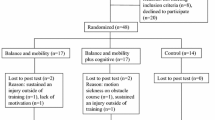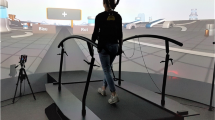Abstract
Useful Field of View (UFOV) computerized cognitive training improves older adults’ gait speed and balance and reduces dementia risk. We investigated a new form of UFOV training requiring physical movement, Training Under Cognitive Kinematics (TUCK). We hypothesized TUCK would be acceptable, feasible, and potentially efficacious to improve UFOV Test and motor performance. Sixty-nine older adults were randomized to TUCK, computerized UFOV training, or an active control group. Cognitive and motor functions were assessed before and immediately after the intervention period. Participants rated TUCK as enjoyable, engaging, and satisfying, indicating acceptability. Eighty-five percent of participants completed TUCK, demonstrating feasibility. Overall, effect sizes for TUCK did not indicate greater efficacy than computerized UFOV training relative to controls. UFOV training showed effect sizes indicating improved balance as measured by Turn 360 (d = 0.37) and Optogait (d = 0.51–0.69) from pre- to post-training relative to controls. Incorporating movement into UFOV cognitive training did not enhance cognitive or motor functional gains. Future investigations are needed to elucidate the underlying mechanisms of UFOV cognitive training to enhance motor function. Research should continue to investigate the association of cognitive and motor function and interventions to improve these outcomes among older adults. The trial and analyses were pre-registered: https://osf.io/7utgw.

Similar content being viewed by others
Data Availability
The deidentified datasets generated during and/or analyzed during the current study are available from the corresponding author on reasonable request. The trial and planned analyses were pre-registered: https://osf.io/7utgw.
Code Availability
Not applicable.
References
Albers, M. W., Gilmore, G. C., Kaye, J. A., Murphy, C., Wingfield, A., Bennett, D. A., et al. (2015). At the interface of sensory and motor dysfunctions and Alzheimer’s disease. Alzheimer’s & Dementia: The Journal of the Alzheimer’s Association, 11, 70–98. https://doi.org/10.1016/j.jalz.2014.04.514
Alzheimer's Association (2012). 2012 Alzheimer's Disease Facts and Figures. http://www.alz.org/downloads/facts_figures_2012.pdf. Accessed March 27 2014.
Ball, K. K., Beard, B. L., Roenker, D. L., Miller, R. L., & Griggs, D. S. (1988). Age and visual search: Expanding the useful field of view. Journal of the Optical Society of America A. Optics and Image Science, 5(12), 2210–2219. https://doi.org/10.1364/JOSAA.5.002210
Blankevoort, C. G., Scherder, E. J., Wieling, M. B., Hortobagyi, T., Brouwer, W. H., Geuze, R. H., et al. (2013). Physical predictors of cognitive performance in healthy older adults: A cross-sectional analysis. PLoS One, 8(7), e70799. https://doi.org/10.1371/journal.pone.0070799
Clark, D. O., Xu, H., Unverzagt, F. W., & Hendrie, H. (2015). Does targeted cognitive training reduce educational disparities in cognitive function among cognitively normal older adults? International Journal of Geriatric Psychiatry. https://doi.org/10.1002/gps.4395
Clouston, S. A., Brewster, P., Kuh, D., Richards, M., Cooper, R., Hardy, R., et al. (2013). The dynamic relationship between physical function and cognition in longitudinal aging cohorts. Epidemiologic Reviews, 35, 33–50. https://doi.org/10.1093/epirev/mxs004
Desjardins-Crepeau, L., Berryman, N., Vu, T. T., Villalpando, J. M., Kergoat, M. J., Li, K. Z., et al. (2014). Physical functioning is associated with processing speed and executive functions in community-dwelling older adults. Journals of Gerontology. Series B: Psychological Sciences and Social Sciences, 69(6), 837–44. https://doi.org/10.1093/geronb/gbu036
Donoghue, O. A., Horgan, N. F., Savva, G. M., Cronin, H., O’Regan, C., & Kenny, R. A. (2012). Association between timed up-and-go and memory, executive function, and processing speed. Journal of the American Geriatrics Society, 60(9), 1681–1686. https://doi.org/10.1111/j.1532-5415.2012.04120.x
Duncan, P. W., Weiner, D. K., Chandler, J., & Studenski, S. (1990). Functional reach: A new clinical measure of balance. Journal of Gerontology, 45(6), M192–M197. https://doi.org/10.1093/geronj/45.6.M192
Edwards, J. D., Clark, D., Xu, H., Guey, L. T., Ross, L. A., & Unverzagt, F. W. (2017a). Speed of processing training results in lower risk of dementia. Alzheimer’s & Dementia: Translational Research & Clinical Interventions, 3, 603–611. https://doi.org/10.1016/j.trci.2017.09.002
Edwards, J. D., Fausto, B. A., Tetlow, A. M., Corona, R. T., & Valdes, E. G. (2017b). Systematic review and meta-analyses of useful field of view cognitive training. Neuroscience and Biobehavioral Reviews. https://doi.org/10.1016/j.neubiorev.2017.11.004
Edwards, J. D., Vance, D. E., Wadley, V. G., Cissell, G. M., Roenker, D. L., & Ball, K. K. (2005a). Reliability and validity of useful field of view test scores as administered by personal computer. Journal of Clinical and Experimental Neuropsychology, 27(5), 529–543. https://doi.org/10.1080/13803390490515432
Edwards, J. D., Wadley, V. G., Vance, D. E., Roenker, D. L., & Ball, K. K. (2005b). The impact of speed of processing training on cognitive and everyday performance. Aging & Mental Health, 9, 262–271. https://doi.org/10.1080/13607860412331336788
Friedman, B., Heisel, M. J., & Delavan, R. L. (2005). Psychometric properties of the 15-item geriatric depression scale in functionally impaired, cognitively intact, community-dwelling elderly primary care patients. Journal of the American Geriatrics Society, 53(9), 1570–1576. https://doi.org/10.1111/j.1532-5415.2005.53461.x
Good-Lite (2010). Sloan letter near vision card. www.good-lite.com
Holtzer, R., Verghese, J., Xue, X., & Lipton, R. B. (2006). Cognitive processes related to gait velocity: Results from the Einstein aging study. Neuropsychology, 20(2), 215–223. https://doi.org/10.1037/0894-4105.20.2.215
Hurd, M. D., Martorell, P., Delavande, A., Mullen, K. J., & Langa, K. M. (2013). Monetary costs of dementia in the United States. New England Journal of Medicine, 368(14), 1326–1334. https://doi.org/10.1056/NEJMsa1204629
Institute, A. N. S. (2010). Specification for audiometers (ANSI S3.6–2010).
Kelly, M. E., Loughrey, D., Lawlor, B. A., Robertson, I. H., Walsh, C., & Brennan, S. (2014). The impact of cognitive training and mental stimulation on cognitive and everyday functioning of healthy older adults: A systematic review and meta-analysis. Ageing Research Reviews, 15, 28–43. https://doi.org/10.1016/j.arr.2014.02.004
Li, K. Z., & Lindenberger, U. (2002). Relations between aging sensory/sensorimotor and cognitive functions. Neuroscience and Biobehavioral Reviews, 26(7), 777–783.
Lienhard, K., Schneider, D., & Maffiuletti, N. A. (2013). Validity of the Optogait photoelectric system for the assessment of spatiotemporal gait parameters. Medical Engineering and Physics, 35(4), 500–504. https://doi.org/10.1016/j.medengphy.2012.06.015
Lin, F., Heffner, K. L., Ren, P., Tivarus, M. E., Brasch, J., Chen, D. G., et al. (2016). Cognitive and neural effects of vision-based speed-of-processing training in older adults with amnestic mild cognitive impairment: A pilot study. Journal of the American Geriatrics Society, 64(6), 1293–1298. https://doi.org/10.1111/jgs.14132
Lin, M. R., Hwang, H. F., Hu, M. H., Wu, H. D., Wang, Y. W., & Huang, F. C. (2004). Psychometric comparisons of the Timed Up and Go, One-Leg Stand, Functional Reach, and Tinetti Balance Measures in community-dwelling older people. Journal of the American Geriatrics Society, 52(8), 1343–1348. https://doi.org/10.1111/j.1532-5415.2004.52366.x
Maquet, D., Lekeu, F., Warzee, E., Gillain, S., Wojtasik, V., Salmon, E., et al. (2010). Gait analysis in elderly adult patients with mild cognitive impairment and patients with mild Alzheimer’s disease: Simple versus dual task: A preliminary report. Clinical Physiology and Functional Imaging, 30(1), 51–56. https://doi.org/10.1111/j.1475-097X.2009.00903.x
Martin, K. L., Blizzard, L., Wood, A. G., Srikanth, V., Thomson, R., Sanders, L. M., et al. (2013). Cognitive function, gait, and gait variability in older people: A population-based study. Journals of Gerontology: Series a, Biological Sciences and Medical Sciences, 68(6), 726–732. https://doi.org/10.1093/gerona/gls224
Nasreddine, Z. S., Phillips, N. A., Bedirian, V., Charbonneau, S., Whitehead, V., Collin, I., et al. (2005). The Montreal Cognitive Assessment, MoCA: A brief screening tool for mild cognitive impairment. Journal of the American Geriatrics Society, 53, 695–699.
Rabipour, S., & Davidson, P. S. (2015). Do you believe in brain training? A questionnaire about expectations of computerized cognitive training. Behavioural Brain Research. https://doi.org/10.1016/j.bbr.2015.01.002.
Rebok, G. W., Ball, K., Guey, L. T., Jones, R. N., Kim, H. Y., King, J. W., et al. (2014). Ten-year effects of the advanced cognitive training for independent and vital elderly cognitive training trial on cognition and everyday functioning in older adults. Journal of the American Geriatrics Society, 62(1), 16–24. https://doi.org/10.1111/jgs.12607
Reuben, D. B., & Siu, A. L. (1990). An objective measure of physical function of elderly outpatients. The Physical Performance Test. Journal of the American Geriatrics Society, 38(10), 1105–1112.
Ross, L. A., Sprague, B. N., & Phillips, C. (2016). The impact of three cognitive training interventions on older adults’ physical functioning across 5 year. Journal of Aging and Health, 30, 475–498. https://doi.org/10.1177/0898264316682916
Shumway-Cook, A., Brauer, S., & Woollacott, M. (2000). Predicting the probability for falls in community-dwelling older adults using the Timed Up and Go Test. Physical Therapy, 80, 896–903.
Smith-Ray, R. L., Hughes, S. L., Prohaska, T. R., Little, D. M., Jurivich, D. A., & Hedeker, D. (2014a). Impact of cognitive training on balance and gait in older adults. Journals of Gerontology Series A Biological Sciences and Medical Sciences, 70, 357–366. https://doi.org/10.1093/geronb/gbt097
Smith-Ray, R. L., Makowski-Woidan, B., & Hughes, S. L. (2014b). A randomized trial to measure the impact of a community-based cognitive training intervention on balance and gait in cognitively intact black older adults. Health Education and Behavior, 41(1S), 62S-69S. https://doi.org/10.1177/1090198114537068
Soumaré, A., Tavernier, B., Alpérovitch, A., Tzourio, C., & Elbaz, A. (2009). A cross-sectional and longitudinal study on the relationship between walking speed and cognitive function in community-dwelling elderly people. Journals of Gerontology: Series A, Biological Sciences and Medical Sciences, 64(10), 1058–1065. https://doi.org/10.1093/gerona/glp077
Verghese, J., Mahoney, J., Ambrose, A. F., Wang, C., & Holtzer, R. (2010). Effect of cognitive remediation on gait in sedentary seniors. Journals of Gerontology. Series A, Biological Sciences and Medical Sciences, 65(12), 1338–1343. https://doi.org/10.1093/gerona/glq127
Wolinsky, F. D., Mahncke, H. W., Vander Weg, M. W., Martin, R., Unverzagt, F. W., Ball, K. K., et al. (2009). The ACTIVE cognitive training interventions and the onset of and recovery from suspected clinical depression. Journals of Gerontology. Series B, Psychological Sciences and Social Sciences, 64B, 577–585. https://doi.org/10.1093/geronb/gbp061
Acknowledgements
This research was funded by the Retirement Research Foundation, grant number 2017-179 to JE and JL. EH, JE, CH, and KB were additionally supported by National Institutes of Health National Institute on Aging (AG058324 and AG056428). We would like to thank our participants for their commitment to our ongoing research. We also thank Jade Sutfin, Raiza Carmenate-Nichols, Hannah Knott, Alice Le, Raquel Doblas-Shaw, and the USF Cognitive Aging Lab staff and volunteers for their roles recruiting participants and collecting study data.
Funding
This study was supported by the Retirement Research Foundation, grant number 2017–179 to JE and JL. EH, JE, CH, and KB were additionally supported by National Institutes of Health National Institute on Aging AG058324 and AG056428. The content is solely the responsibility of the authors and does not necessarily represent the official views of the National Institutes of Health.
Author information
Authors and Affiliations
Contributions
Conceptualization, JE and JL; Methodology, JE, JL, EH, and LG; Formal analysis, JE, KB, and EH; investigation, EH, JL, LG, and JE; resources, JE; data curation, CH, KB, EH, and JE; writing (original draft preparation), EH, KB, CH, and JE; writing (review and editing), EH, JL, LG, JE, and KB; project administration, EH and JE; funding acquisition, JE and JL.
Corresponding author
Ethics declarations
Ethics Approval
The study was approved by the USF Institutional Review Board prior to data collection. We certify that this study was performed in accordance with the ethical standards as ladi down in the 1964 Declaration of Helsinki.
Consent to Participate
Informed consent was obtained from all individual participants included in the study.
Consent for Publication
Participants signed informed consent regarding publishing their deidentified data.
Conflict of Interest
Dr. Edwards worked between 1996 and 2005 as a consultant conducting related research studies for Visual Awareness, Inc., who owned the intellectual property surrounding the speed of processing training software. Posit Science now markets the UFOV training program. Over an approximate 3-month period in 2008, Dr. Edwards worked as a limited consultant to Posit Science, Inc. to analyze data and prepare a publication. Dr. LaVere has consulted with and received equipment from Microgate, the developers of Optogait. The remaining authors declare no conflict of interest. The funders had no role in the collection, analyses, or interpretation of data; in the writing of the manuscript, or in the decision to publish the results.
Additional information
Publisher’s Note
Springer Nature remains neutral with regard to jurisdictional claims in published maps and institutional affiliations.
Rights and permissions
About this article
Cite this article
Hudak, E.M., Bell, K.L., Hall, C. et al. Dynamic Useful Field of View Training to Enhance Older Adults’ Cognitive and Motor Function: a Pilot Study. J Cogn Enhanc 5, 411–419 (2021). https://doi.org/10.1007/s41465-021-00219-2
Received:
Accepted:
Published:
Issue Date:
DOI: https://doi.org/10.1007/s41465-021-00219-2




